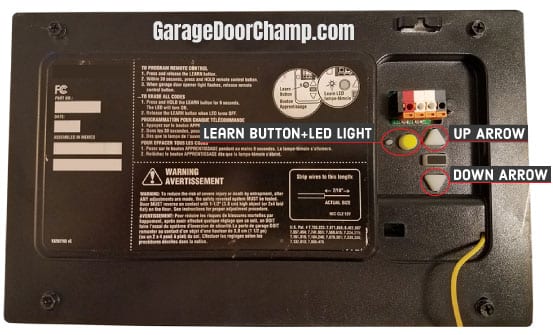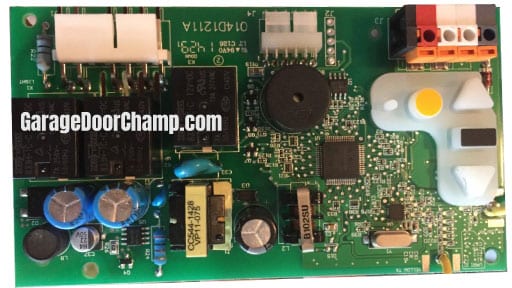A malfunctioning garage door that has stopped working can lead to numerous problems for you and your household. If your garage door is stuck open, it exposes your home to adverse weather conditions and potential security risks. Additionally, it can hinder your ability to access your vehicles parked in the garage, causing disruptions to your daily routine.
Fortunately, many garage door opener manufacturers have integrated features into their electric openers to help identify and address these issues efficiently.
Many modern garage door openers come equipped with an LED troubleshooting system that indicate potential issues. While these codes are helpful, they can still be cryptic. In this article, our aim is to provide you with an in-depth guide to troubleshooting your malfunctioning garage door.

LiftMaster, Chamberlain, and Craftsman garage door openers are equipped with a single LED light that blinks to indicate faults. Openers with a yellow learn button will also feature up and down arrows that blink in a sequence to indicate faults. While these lights can guide you in the right direction to identify potential issues, additional inspections are necessary to discover and address any problems.
Fixing a Garage Door Opener That Will Not Work
Before you begin searching for complicated error codes on your garage door opener, it’s essential to ensure that the garage door itself is in good working order. Look for any signs of breakage, wear, or objects that may obstruct its movement. Additionally, check the functioning of the outlet and circuit breaker.
To further assess the situation, pull the emergency release handle of your garage door and attempt to manually move the door up and down. Be cautious not to exert excessive physical force during this process. Inspect the tracks for any bends, loose nuts, bolts, or irregularities that might be obstructing the door’s movement.
If there is no obvious damage, check for wear along the garage door opener’s rail. Try to activate the door and observe the trolley moving across the rail in both directions.
For openers with a screw rail assembly, a loud grinding noise from the opener’s rail may result from a worn drive rack or trolley. If the opener’s motor runs but the screw doesn’t turn, it could indicate a broken coupler.
Chain or belt garage door openers that run but won’t move the door up and down may have a worn gear and sprocket assembly.
Troubleshooting Errors with LiftMaster, Chamberlain and Craftsman
An opener error code can include a wide range of issues. In this guide, we focus on garage openers with a yellow learn button that are malfunctioning due to the following error codes:
Diagnostic code: The up arrow flashes 1 time, followed by the down arrow also flashing 1 time.
- Scenario: The garage door won’t close.
- Solution: The opener sensors are either not installed or not connected properly, and there may be damaged wires. Please install the safety sensors or replace any damaged wires as necessary.
Diagnostic code: The up arrow flashes 1 time, followed by the down arrow also flashing 2 times.
- Scenario: The garage door won’t close.
- Solution: A short circuit has occurred due to faulty wiring in the sensor. Please inspect the wires and replace them as required.
Diagnostic code: The up arrow flashes 1 time, followed by the down arrow also flashing 3 times.
- Scenario: The garage door wall button won’t work.
- Solution: The wall button may be defective, or a short circuit could be the result of faulty wiring. Inspect the wall button wires, and replace either the wires or the wall button as needed.
Diagnostic code: The up arrow flashes 1 time, followed by the down arrow also flashing 4 times.
- Scenario: The garage door wall button won’t work.
- Solution: The wall button may be defective, or a short circuit could be the result of faulty wiring. Inspect the wall button wires, and replace either the wires or the wall button as needed.
Diagnostic code: The up arrow flashes 1 time, followed by the down arrow also flashing 5 times.
- Scenario: The garage door moves a few inches (approximately 5-9 inches), then stops or reverses.
- Solution: Disengage the garage door from the opener using the emergency release. Test the door manually to check for any breakages or obstructions, such as broken parts or objects blocking the doorway. Additionally, inspect the electrical wiring connections inside the motor leading to the travel module and the motherboard. If necessary, consider replacing the travel module.
Diagnostic code: The up arrow flashes 1 time, followed by the down arrow also flashing 5 times.
- Scenario: The opener does not respond but makes a single clicking sound.
- Solution: Test the garage door manually to check for any breakages or obstructions. If the issue persists, consider replacing the motherboard.
Diagnostic code: The up arrow flashes 1 time, followed by the down arrow also flashing 5 times.
- Scenario: The opener hums for 2 seconds and does not move.
- Solution: Test the garage door manually to check for any breakages or obstructions. If the opener is still malfunctioning, it may need to be replaced.
Diagnostic code: The up arrow flashes 1 time, followed by the down arrow also flashing 6 times.
- Scenario: The garage door coasts after opening.
- Solution: Try to reprogram the opener’s travel limits. The garage door may need to be re-calibrated or have the garage door springs inspected by a certified garage door technician.
Diagnostic code: The up arrow flashes 2 times, followed by the down arrow also flashing 1-5 times.
- Scenario: The opener does not respond, no sound.
- Solution: Try resetting the opener by unplugging it. If the issue persists, consider replacing the motherboard.
Diagnostic code: The up arrow flashes 3 times, followed by the down arrow also flashing 2 times.
- Scenario: The opener’s travel limits cannot be programmed.
- Solution: Inspect the travel module. Replace it if necessary.
Diagnostic code: The up arrow flashes 3 times, followed by the down arrow also flashing 3 times.
- Scenario: The battery backup won’t charge. Battery backup LED light flashing constantly.
- Solution: Replace the opener’s motherboard.
Diagnostic code: The up arrow flashes 4 times, followed by the down arrow also flashing 1-4 times.
- Scenario: The door moves then stops or reverses. The opener makes a beeping sound and lights flash.
- Solution: Inspect the door for broken springs or other breakage. Test the garage door manually to check for any obstructions, binding or sticking. Reprogram the opener travel limits and force.
Diagnostic code: The up arrow flashes 4 times, followed by the down arrow also flashing 5 times.
- Scenario: The garage door moves a few inches (approximately 5-9 inches), then stops or reverses.
- Solution: Inspect the connections to the opener’s travel module. Replace the travel module it if necessary.
Diagnostic code: The up arrow flashes 4 times, followed by the down arrow also flashing 6 times.
- Scenario The garage door won’t close.
- Solution: The safety sensors may be obscured or misaligned. Check the alignment of the sensors, and clean the sensor lenses with a dry washcloth. If the issue persists, consider replacing the sensors as necessary.

As mentioned earlier, these issues can be quite broad, making it challenging to identify the precise reason why the garage door opener isn’t functioning. When addressing a garage door opener problem, our initial recommendation is to check for basic issues before delving into more complex ones. Ideally, your garage door may only need a simple fix.
If the opener’s motor has overheated, the best course of action is to leave it undisturbed for approximately 30 minutes to an hour to allow it to cool down. Afterward, attempt to use it again. If it operates correctly at this point, the issue was likely due to an overheated motor.
Keep in mind that experiencing issues with your garage door opener doesn’t necessarily mean that the opener itself is defective. Broken springs, worn rollers, misaligned parts, tracks and mechanisms, as well as garage doors that aren’t functioning properly or are imbalanced, can affect the normal operation of the electric opener.









My garage door has been having problems opening, and I’m not sure what to do. It makes sense that I would want to get a professional to help! They would be able to make the process a whole lot easier.